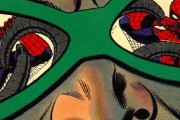The beautiful thing about collecting comic books is you have a fully equipped library of classic pulp fiction waiting for you whenever you’re in the mood to read. And obviously, I would have never settled on being an Amazing Spider-Man collector, if I didn’t love to read Amazing Spider-Man comics. But while I’ll frequently dissect the storylines and themes of the newest issues coming out, I’m yet to write with any regularity about the reading experience of my collection’s “back issues.” So consider these “Reading Experience” entries as my exploration into my favorite storylines, writers, panels and covers (among other things) from my Amazing Spider-Man collection.
***
If it were up to me, Stan Lee and Steve Ditko would receive every honor imaginable: put their faces on money, anoint them as saints, induct them into every professional sports hall of fame, etc. Lee and Ditko gave the world Spider-Man, and for that, I am eternally grateful.
An added treat about the way I’ve gone about collecting every issue of Amazing Spider-Man – essentially backwards – is I’m just now getting to experience those first Lee/Ditko stories in their original form. Yes, I’ve read a number of those first 38 issues years ago, as reprints or in collected anthologies. But reading those original stories on the original paper, with the original ink they were printed with, adds a tremendous amount to the experience. I subscribe to the thought that like a bottle of wine – every comic book is different. The paper feels different. Maybe the first owner dog-eared a page. Maybe he wrote his initials somewhere inside or cut a coupon out (hopefully it doesn’t affect the story!). Comics all smell different. Maybe a previous owner was a smoker, or he kept them in a box in a moldy basement. Maybe the issue was mailed to someone and creased down the middle so it could fit in a mailbox. This is why I always try to read every comic I buy, just to absorb the experience and to wonder.
But by reading these Lee/Ditko stories now, I’m also approaching this with a bit more perspective. I’ve been reading Spider-Man comics for more than 20 years now. I’ve seen numerous creative teams attempt to adapt and change the character, make him more current, drive up sales, etc. That doesn’t mean the quality of Amazing Spider-Man has gone down. It’s just a different animal.
Here are just a couple of things about the Lee/Ditko stories that really stand out to me as different and unique:
Bang for your buck: Reading the earliest ASM’s is almost daunting. Lee and Ditko pack so much into their standard page. There are usually nine panels per page, with plenty of text – narration and dialogue. Here’s a page from the recently purchased ASM #8:
For more modern comics, I can usually read through a full book in about 15 minutes, but it takes time to get through every detail of the Lee/Ditko books. As a result, I think the artwork suffers a bit. Yes, I know, it’s blasphemy to criticize Ditko since he’s the originator, but in terms of the “classic” artists, I’ve always been more partial to John Romita Sr. Ditko created Spider-Man, but Romita refined him. And even when there’s a lot going on in an early Lee/Romita page, it just feels a little more spread out and open. Here’s a typical page, as taken from ASM #50:
Stan’s the Salesman: Stan Lee has become a bit of a caricature is his later years, usually making goofy cameos in the all of the Marvel movies (though his cameo in Kevin Smith’s Mallrats remains one of my all-time favorite movie moments). But there’s something to be said about Stan’s hokey narration in these early comics that’s just completely sincere and endearing. For me, Stan always shines on the intro page. It’s the first page of each issue and after reading a few of Lee’s narrations, you can tell he BELIEVES that he’s selling an awesome product here. And if the writer believes it so blatantly, then you as the reader have to believe it.
A great example of this is ASM #14, the first appearance for the Green Goblin. Lee totally breaks down the fourth wall and introduces the Goblin by saying “the gang at the bullpen” wanted to “give our fans the greatest 12 cents worth we can.” So they created a “really different villain.” Goblin would go on to become Spider-Man’s arch-nemesis and while hindsight is 20-20, just reading Stan’s intro makes me believe that was his intentions for the villain all along.
And just for fun, Stan notes that ASM #14 also has a teaser for the Hulk on the cover, so he tells his fans: “don’t be impatient! The Hulk doesn’t appear till later on in the story … but you’ll be glad you waited.” Again, he’s letting his readers know, this is no gimmick. We promised you the Hulk, and you’ll get him. But read Spider-Man first. I love the kitsch.
I could go on and on about Lee/Ditko, but I thought I’d start with these general differences that just really stand out to me. Again, I’m not reminiscing and saying that this is how all comics should read in 2011. But to see this level of charm, and this strong desire to give readers as much story as can be packed into a comic is something to behold.







To me, the Ditko/Lee/Romita era feels like rediscovering art and storytelling renaissance through comic books.
I can’t remember any other example in which I felt so gripped by everything: characterization, plot, art and everything else.
Nothing beats these comics; nothing.